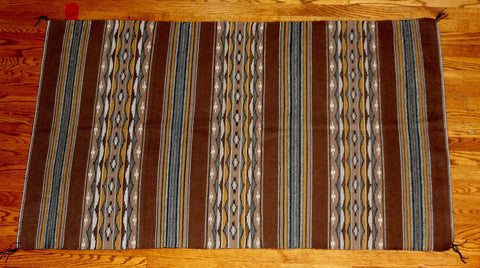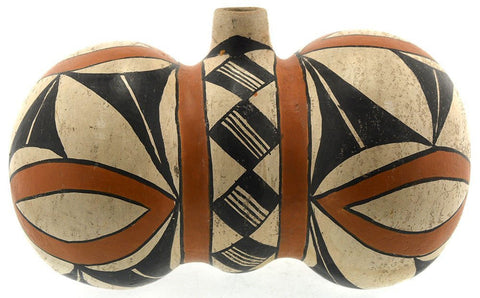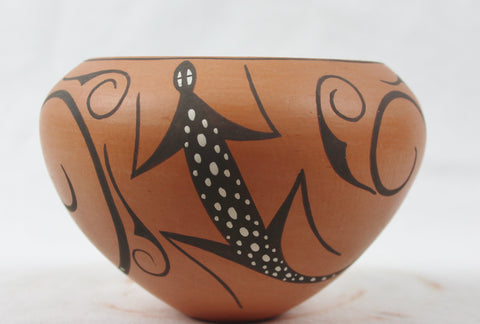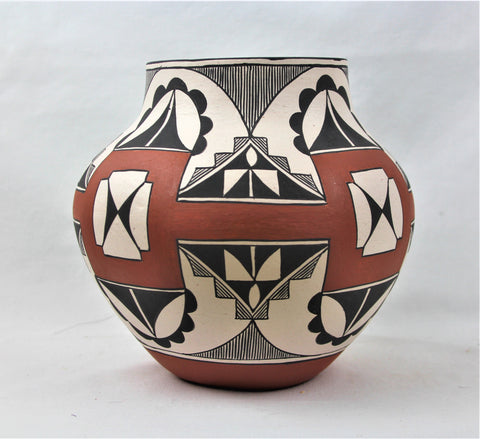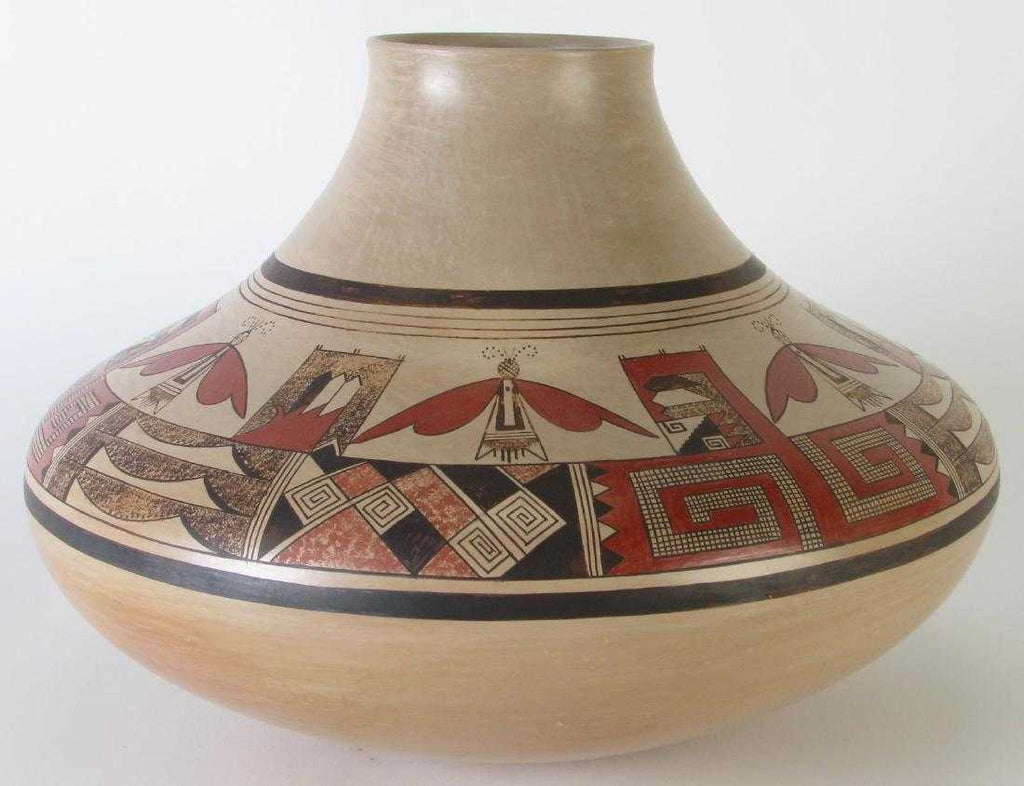
Native American Hopi Pottery Jar by James Nampeyo, Ca 1980's, #1372 SOLD
$ 4,724.00
Native American Hopi Pottery Jar by James Nampeyo, Ca 1980's, #1372
Description: #1372 Native American Hopi Pottery Jar by James Nampeyo, Ca 1980's. Handmade pottery of natural clay indigenous to the area using mineral stones for the paint and is hand coiled in the traditional technique. Artist painted the Old Sityaki designs in the poly chrome technique. Artist signed "James G. Nampeyo, "corn stalk" on the bottom.
Dimensions: 10.5" tall x 15" in diameter.
Provenance: From an estate in Scottsdale AZ.
Condition: Very good for its age. Two minor scratches on the bottom.
James Nampeyo is a very talented potter from First Mesa with deep roots in traditional Hopi pottery. James is the great-grandson of the famed Nampeyo , son of Leah and Rayvin Garcia Nampeo, husband of the second Fawn Navasie. His favorite designs are Thunder birds, eagle tails, clowns, feathers. He has been highlighted in Bassman 1997-77, and Dillingham 1994 m 14-15 and is in a number of biographical data bases to include: Hopi-Tewa Potters, Native American Resource Collection, Heard Museum, Phoenix; Artist Database, Museum of Indian Arts and Cultures, Santa Fe.
“Pueblo pottery is made using a coiled technique that came into northern Arizona and New Mexico from the south, some 1500 years ago. In the four-corners region of the US, nineteen pueblos and villages have historically produced pottery. Although each of these pueblos use similar traditional methods of coiling, shaping, finishing and firing, the pottery from each is distinctive. Various clays gathered from each pueblo’s local sources produce pottery colors that range from buff to earthy yellows, oranges, and reds, as well as black. Fired pots are sometimes left plain and other times decorated—most frequently with paint and occasionally with appliqué. Painted designs vary from pueblo to pueblo, yet share an ancient iconography based on abstract representations of clouds, rain, feathers, birds, plants, animals and other natural world features.
Tempering materials and paints, also from natural sources, contribute further to the distinctiveness of each pueblo’s pottery. Some paints are derived from plants, others from minerals. Before firing, potters in some pueblos apply a light colored slip to their pottery, which creates a bright background for painted designs or simply a lighter color plain ware vessel. Designs are painted on before firing, traditionally with a brush fashioned from yucca fiber.
Different combinations of paint color, clay color, and slips are characteristic of different pueblos. Among them are black on cream, black on buff, black on red, dark brown and dark red on white (as found in Zuni pottery), matte red on red, and polychrome—a number of natural colors on one vessel (most typically associated with Hopi). Pueblo potters also produce undecorated polished black ware, black on black ware, and carved red and carved black wares.
Making pueblo pottery is a time-consuming effort that includes gathering and preparing the clay, building and shaping the coiled pot, gathering plants to make the colored dyes, constructing yucca brushes, and, often, making a clay slip. While some Pueblo artists fire in kilns, most still fire in the traditional way in an outside fire pit, covering their vessels with large potsherds and dried sheep dung. Pottery is left to bake for many hours, producing a high-fired result.
Today, Pueblo potters continue to honor this centuries-old tradition of hand-coiled pottery production, yet value the need for contemporary artistic expression as well. They continue to improve their style, methods and designs, often combining traditional and contemporary techniques to create striking new works of art.” (Source: Museum of Northern Arizona)
Description: #1372 Native American Hopi Pottery Jar by James Nampeyo, Ca 1980's. Handmade pottery of natural clay indigenous to the area using mineral stones for the paint and is hand coiled in the traditional technique. Artist painted the Old Sityaki designs in the poly chrome technique. Artist signed "James G. Nampeyo, "corn stalk" on the bottom.
Dimensions: 10.5" tall x 15" in diameter.
Provenance: From an estate in Scottsdale AZ.
Condition: Very good for its age. Two minor scratches on the bottom.
James Nampeyo is a very talented potter from First Mesa with deep roots in traditional Hopi pottery. James is the great-grandson of the famed Nampeyo , son of Leah and Rayvin Garcia Nampeo, husband of the second Fawn Navasie. His favorite designs are Thunder birds, eagle tails, clowns, feathers. He has been highlighted in Bassman 1997-77, and Dillingham 1994 m 14-15 and is in a number of biographical data bases to include: Hopi-Tewa Potters, Native American Resource Collection, Heard Museum, Phoenix; Artist Database, Museum of Indian Arts and Cultures, Santa Fe.
“Pueblo pottery is made using a coiled technique that came into northern Arizona and New Mexico from the south, some 1500 years ago. In the four-corners region of the US, nineteen pueblos and villages have historically produced pottery. Although each of these pueblos use similar traditional methods of coiling, shaping, finishing and firing, the pottery from each is distinctive. Various clays gathered from each pueblo’s local sources produce pottery colors that range from buff to earthy yellows, oranges, and reds, as well as black. Fired pots are sometimes left plain and other times decorated—most frequently with paint and occasionally with appliqué. Painted designs vary from pueblo to pueblo, yet share an ancient iconography based on abstract representations of clouds, rain, feathers, birds, plants, animals and other natural world features.
Tempering materials and paints, also from natural sources, contribute further to the distinctiveness of each pueblo’s pottery. Some paints are derived from plants, others from minerals. Before firing, potters in some pueblos apply a light colored slip to their pottery, which creates a bright background for painted designs or simply a lighter color plain ware vessel. Designs are painted on before firing, traditionally with a brush fashioned from yucca fiber.
Different combinations of paint color, clay color, and slips are characteristic of different pueblos. Among them are black on cream, black on buff, black on red, dark brown and dark red on white (as found in Zuni pottery), matte red on red, and polychrome—a number of natural colors on one vessel (most typically associated with Hopi). Pueblo potters also produce undecorated polished black ware, black on black ware, and carved red and carved black wares.
Making pueblo pottery is a time-consuming effort that includes gathering and preparing the clay, building and shaping the coiled pot, gathering plants to make the colored dyes, constructing yucca brushes, and, often, making a clay slip. While some Pueblo artists fire in kilns, most still fire in the traditional way in an outside fire pit, covering their vessels with large potsherds and dried sheep dung. Pottery is left to bake for many hours, producing a high-fired result.
Today, Pueblo potters continue to honor this centuries-old tradition of hand-coiled pottery production, yet value the need for contemporary artistic expression as well. They continue to improve their style, methods and designs, often combining traditional and contemporary techniques to create striking new works of art.” (Source: Museum of Northern Arizona)
Related Products
Sold out
Sold out
Sold out





